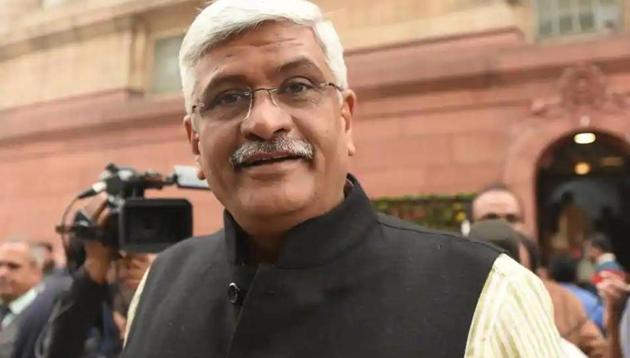Will meet piped water target despite outbreak: Jal Shakti minister
The coronavirus disease (Covid-19) pandemic has made no difference to India’s stated goal of providing piped water to all households by 2024, Jal Shakti minister Gajendra Singh Shekhawat said
The coronavirus disease (Covid-19) pandemic has made no difference to India’s stated goal of providing piped water to all households by 2024, Jal Shakti minister Gajendra Singh Shekhawat said. In an interview to Hindustan Times, Shekhawat conceded that in some states, it was a challenge to provide water for frequent washing of hands that health experts advise as a way of keeping the virus at bay.

He added: “Looking towards the challenge itself, PM had envisaged this programme (Jal Jeevan Mission) . You may call it luxury but we are going to achieve it in the targeted time.” Edited excerpts:
Your ministry’s objective has been to provide tap water to all by 2024. Has the coronavirus disease pandemic made any difference to the plan?
No, not at all. We are still set for our goals for 2024 and providing functional drinking water to every household. Before this Covid period, we were working hard ever since PM announced this on 15 August from Red Fort. We requested states to collect the low hanging fruits-- villages that already have existing, sustainable sources of water -- could start retrofitting pipes. I can proudly say that we have achieved our goal for the first year. Simultaneously, during the Covid period, the 2.5 months, we were not sitting idle. We repeatedly did meetings with states and ministers. We wanted to use this period to complete the planning for the implementation of this programme. We requested them to make their state execution plan for this year and the remaining three years.
So you are completing the theoretical part during the lockdown?
Yes and as soon as the construction activity was allowed in Lockdown 2, we asked states to start work as soon as possible. Today, for example, I had meetings with Chattisgarh CM and Madhya Pradesh CM and I have requested CMs to use the Jal Jeevan Mission as a programme to provide employment at the grassroots level. Since each and every village has to be provided piped water, every village will have work for laying pipes, digging trenches, etcetera. MNREGA {Mahatma Gandhi National Rural Employment Guarantee Act} budget has been increased, so we have asked states to utilise that money as well by consolidating funds so you are providing employment and achieving (piped water) targets.
So there is a convergence of supply and demand? But your ministry data says only 18% people have piped water right now. So how difficult is it for people to practice washing of hands?
It is really challenging, but water was not available as a whole but through the water drinking water programme and work of the states over the years, it was available in the close vicinity. Whether it is in the 50-100 metres and for some other villages, it is a longer distance, but still it was available. We wrote a letter to the states during the lockdown, to ensure sustainable water supply through those public standposts or common sources of water.
But practically speaking, it must be a problem. Isn’t it a luxury to be able to wash hands frequently? Especially in states like West Bengal and Uttar Pradesh, which have only 1%, and Biha, which has 2% households with piped water.
It is a challenge. Looking towards the challenge itself, PM had envisaged this programme (Jal Jeevan Mission) . You may call it luxury but we are going to achieve it in the targeted time.
What do you make of the side effects that we are seeing of the lockdown? Reports that the Ganga has become much cleaner. Do you fear that things will immediately go back as soon as the lockdown ends?
There are three visible causes of water pollution--sewage, industrial effluents and third, by human interactions. Out of three, two were closed--industry and the human interactions, due to the lockdown. Because of that there are changes which have been observed in the quality of water but as far as the Ganga is concerned, it’s not a major difference. In the Ganga, in the last Kumbh last year, 22 crore people observed changes in the quality of water. That’s because of the mission mode effort under the PM of Namami Gange. In the month of October- November, we did a rafting expedition from Devprayag to Rishikesh. In those 90 odd kilometres, I just picked up some water from the river in my glass and it was absolutely potable. In this season, as the water comes from melting snow, it appears comparatively better. Similiar position is also in the Yamuna water, there was significant rainfall which increased the water in the river. It was a coincidence that there were untimely rains otherwise we only see sewage in the Yamuna in this period. Water for harvest was also not taken out of the river so quantity of water increased.
Looking at the industrial shutdown as an opportunity, Prime Minister instructed us to take samples of the river and use this period as an opportunity to study, how much pollution is contributed through industrial effluence. This can be used for future planning.
So how will you use it?
We have collected all the data of different stretches of the Yamuna and Ganga during the lockdown period. Now we are able to tell how much pollution is contributed by sewage in the city and how much by industries. So we have tied up with Central Pollution Control Board and also with the IITs {Indian Institutes of Technology} apart from our internal bodies so at the end of it, we’ll have extensive data on this.






